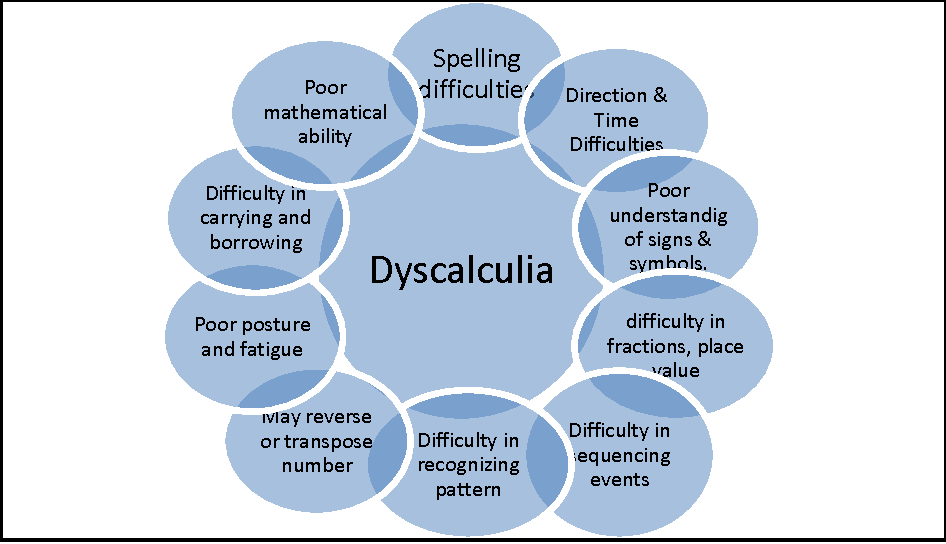Dyscalculia: Symptoms, Causes, Prevention & Treatment
Dyscalculia is a math learning condition that hinders a person’s ability to understand number-related ideas, execute correct arithmetic computations, reason and problem solve, and perform other fundamental math abilities. Dyscalculia is often known as “number dyslexia” or “math dyslexia.”
Overview of Dyscalculia:
About 11% of children with attention deficit hyperactivity disorder (ADHD) have dyscalculia . Other learning abnormalities are also frequent, such as dyslexia and dysgraphia. Up to 45 percent of children with ADHD have some type of learning difficulties.
Dyscalculia is usually associated with dyslexia, a reading learning disability. Approximately half of children with dyscalculia also have dyslexia. While estimates vary, the estimated prevalence of dyscalculia in school populations is from 3 to 6%.
Individuals with dyscalculia struggle with all aspects of arithmetic. These are mathematical challenges that cannot be explained by a lack of sufficient education, intellectual disability, or other circumstances.

Symptoms of Dyscalculia
Dyscalculia is defined by difficulty with basic arithmetic activities. Among these challenges are:
- Difficulty deciphering analog clocks
- Difficulty determining which of two numbers is greater
- Sequencing problems
- Inability to grasp financial planning or budgeting even at a basic level, such as calculating the cost of things in a shopping cart or balancing a checkbook.
- Perceiving numbers as meaningless or incomprehensible symbols rather than text conveying a numerical value (hence the misnomer, “math dyslexia”)
- Difficulties with multiplication, subtraction, addition, and division tables, mental arithmetic, and other mathematics.
- Inaccurate addition, subtraction, multiplication, and division results
- Errors in number additions, replacements, transpositions, omissions, and reversals may occur while writing, reading, and recalling numbers.
- Poor math concept memory (retention and retrieval). They may be able to complete arithmetic operations one day but draw a blank the next or they may be able to accomplish book work but fail tests
- Understanding of arithmetic on a conceptual level, but unable to apply those principles
- Difficulty remembering the names of numbers or believing that certain numbers “feel” the same (e.g. frequently interchanging the same two numbers for each other when reading or recalling them)
- Difficulties distinguishing between left and right
- A “distorted” sense of spatial awareness, or a grasp of forms, distance, or volume that appears to be based on conjecture rather than genuine cognition
- Difficulties with time, directions, reading maps, memorizing timetables, event sequences, keeping track of time, frequently late or early
- Difficulty working backward in time (e.g., when to depart if you need to be someplace at ‘X’ time)
- Difficulties in reading musical notes
- Difficulty performing coordinated steps of a dance
- Having trouble mentally calculating the size of an item or distance (for example, whether something is 3 or 6 meters (10 or 20 feet) away)
- Inability to comprehend and recall mathematical ideas, rules, equations, and sequences
- Inability to focus on intellectually demanding tasks
- Incorrect remembering of names, poor name/face retrieval; names beginning with the same letter may be substituted.
- Some persons with dyscalculia also have aphantasia, which inhibits their ability to “see” in their minds’ eye. People without dyscalculia report experiencing this as well, although it is more common in individuals with dyslexia and other learning challenges.
Committed to helping
people who want to help themselves
What are the Causes?
Most people conceive dyscalculia in terms of developmental dyscalculia, which refers to difficulty in learning and completing basic math skills. The exact reasons for this sort of dyscalculia are unknown, although research suggests that difficulties in brain development and heredity (since the impairment tends to run in families) might be to blame. Acquired dyscalculia, also known as acalculia, is a loss of mathematical abilities and conceptions caused by disruptions such as brain damage and other cognitive impairments.
Diagnosis of Dyscalculia
The only way to know for sure if your child has the disorder is to get them tested. The examination is also known as educational or psychoeducational testing. The exams focus on four important areas:
- Computational skills
The ability to do mathematical procedures. Younger children may be given addition or subtraction problems, while older children may be given more difficult problems like as multiplication, division, and fractions.
- Math fluency
The ability to recall fundamental math concepts such as 5 x 3 = 15 or how to multiply fractions quickly.
- Mental computation
The capacity to solve math problems mentally.
- Quantitative reasoning
The capacity to comprehend and solve word puzzles.
An expert may review these tests and compile a report that will assist you in addressing your child’s requirements.
Where can it be Treated?
Learning experts, educational psychologists, or neuropsychologists that specialize in dyscalculia prescribe the following to improve a child’s math understanding:
- Specifically prepared lesson plans
- Math-based educational games
- Practicing math skills far more often than other fellow mates
How do you help a child having Dyscalculia?
- Allow children to count with their fingers and paper.
- Ensure they have the necessary tools, such as an easy-to-use calculator and lots of erasers.
- Utilize graph paper. It aids in keeping columns and numbers straight and tidy.
- Rhythm and music may be used to teach math facts and steps.
- Enlist the assistance of an expert math tutor.
- Create visual representations of arithmetic word problems.
- Set aside time on the computer to play math games.
- Recognize their efforts rather than the outcome.
- Discuss their learning difficulty with them.
- Teach them how to cope with anxiousness.
